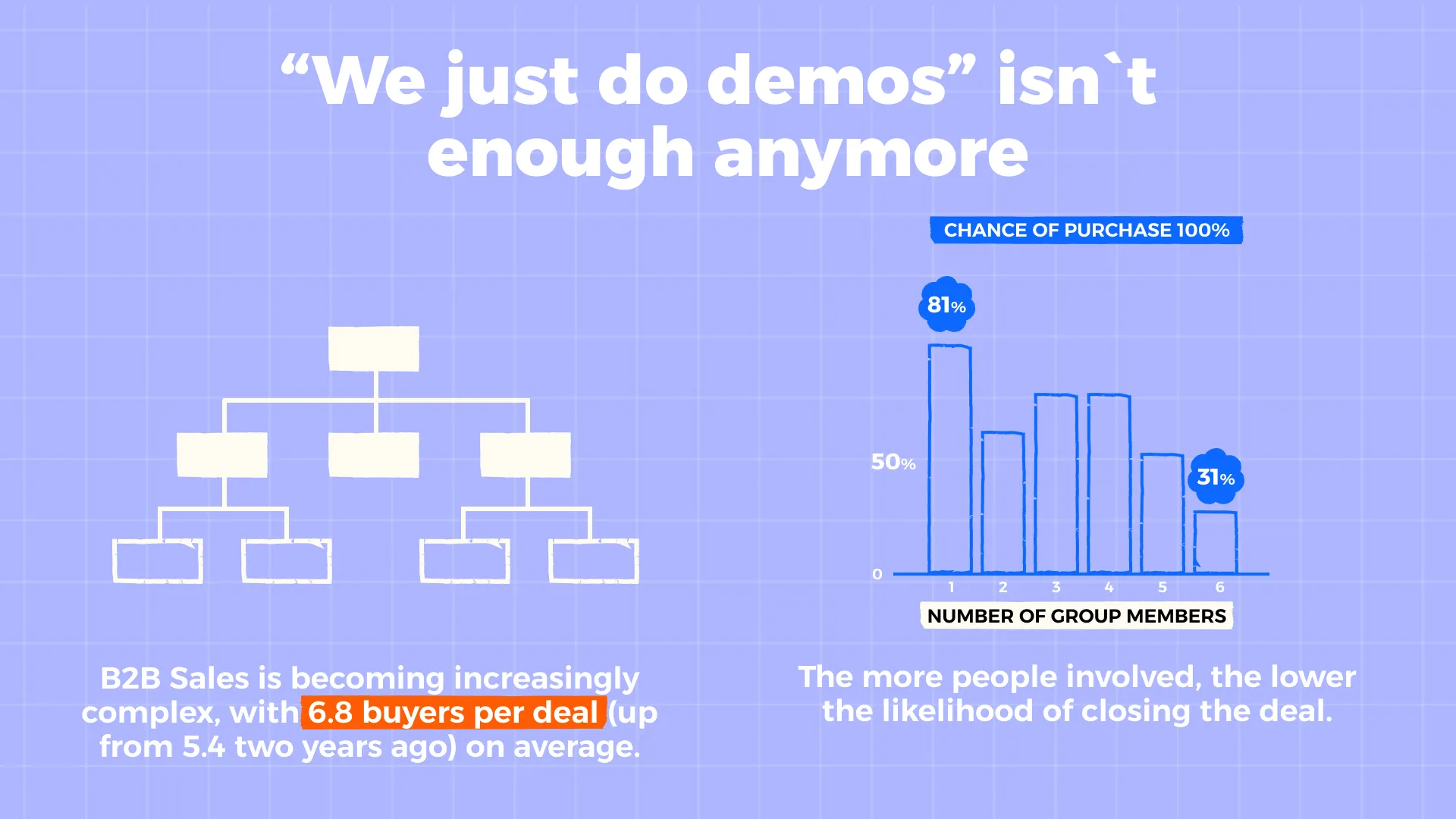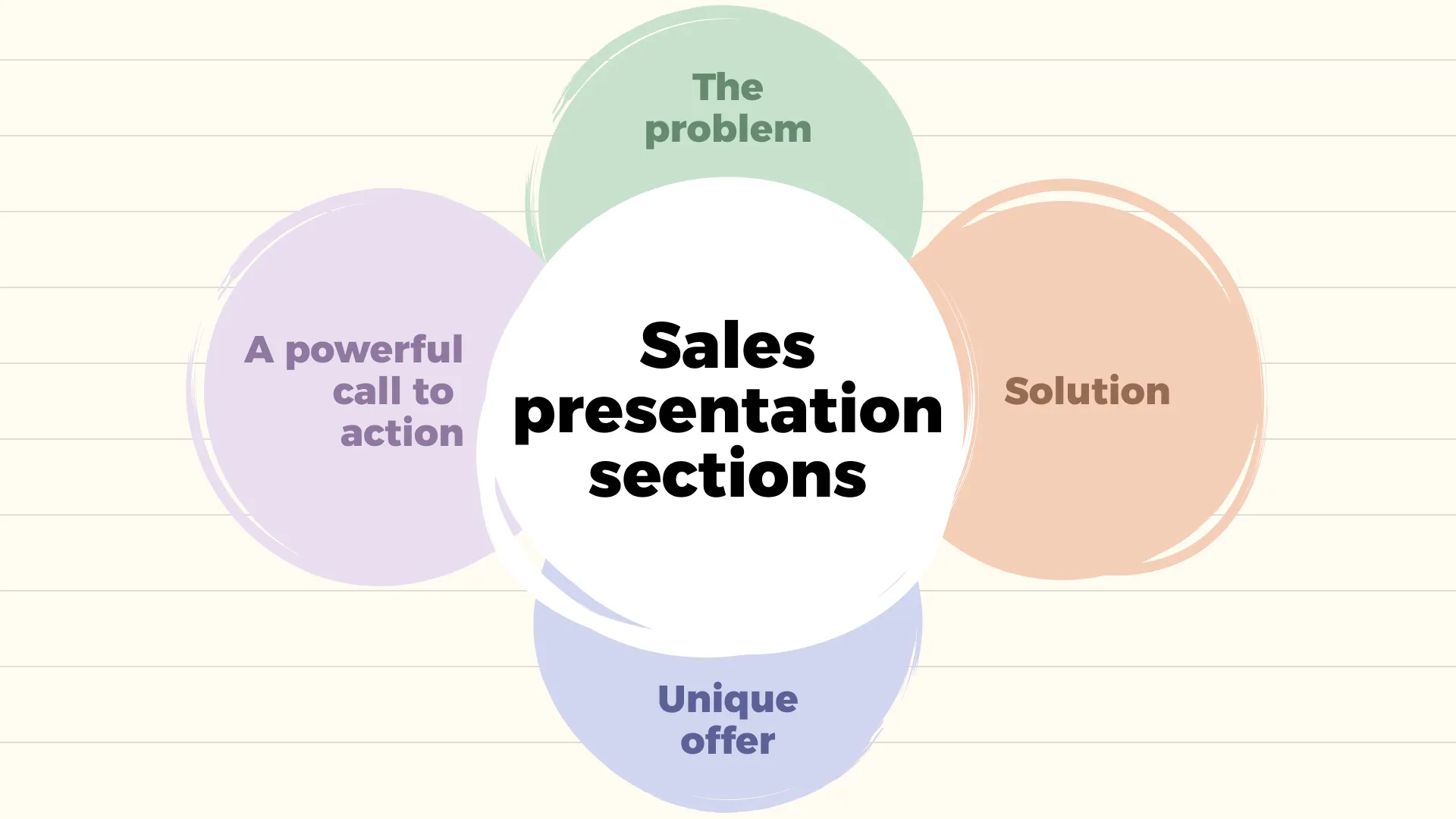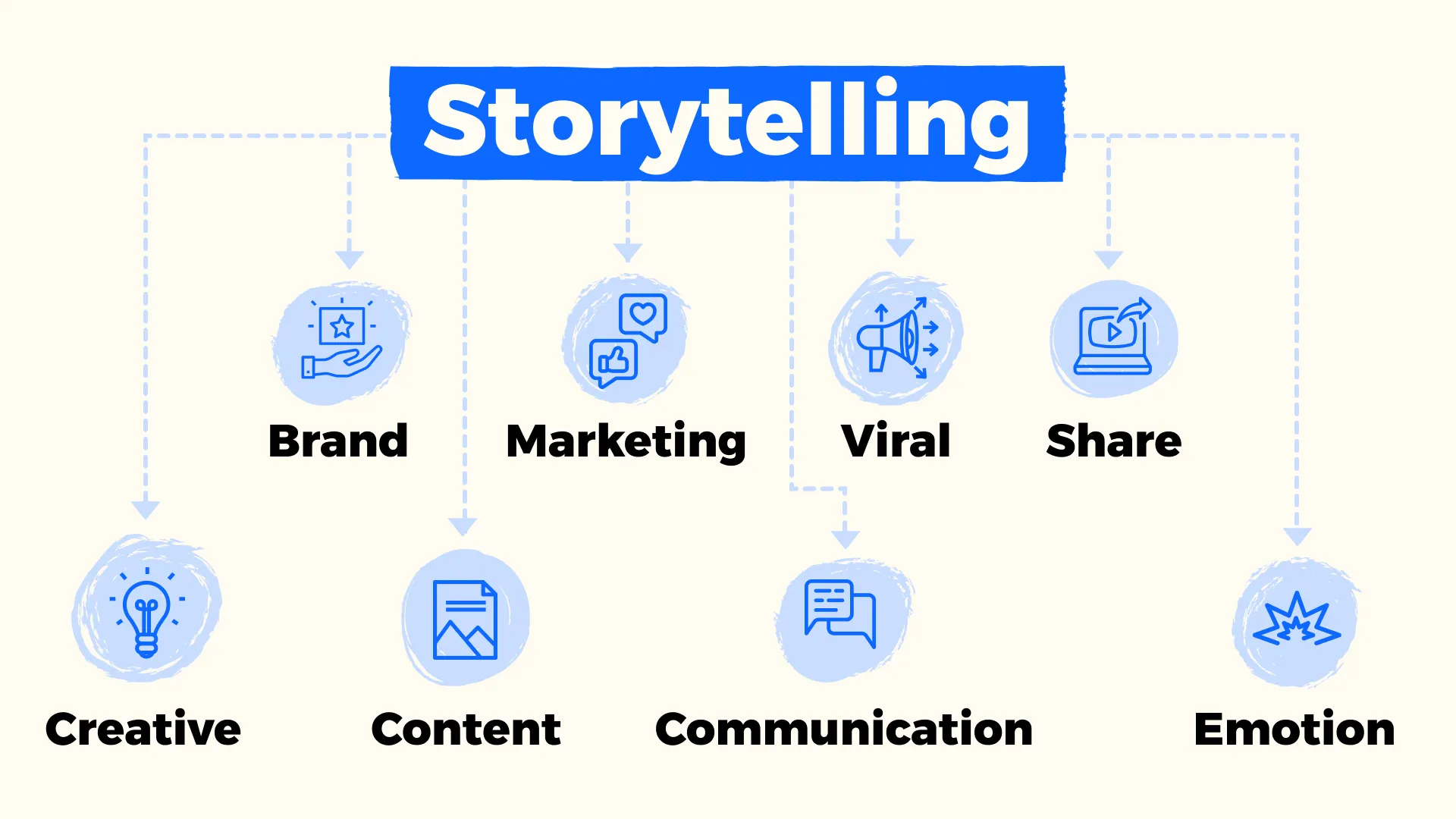
How to Create a Sales Deck That Works: Tips for Success
.webp)
Developing a compelling idea, attracting investment, and creating a high-quality product are important, but they are only part of the story. Equally crucial is your ability to sell your product effectively. This requires presenting it in the best possible light – a fundamental aspect of successful sales. Without this skill, even the most outstanding product can remain overlooked, and your business may falter, becoming stagnant and uninspiring.
In today's competitive market, you need to pursue growth relentlessly. Traditional sales demonstrations no longer have the punch to boost sales and attract customers. At some point, you must step outside your comfort zone and embrace the power of public presentation. This strategy capitalizes on visibility, fostering a direct perception of information about your product. The goal is to create striking visual, verbal, and other sensory impressions that cultivate the desired perception.
Does it sound straightforward? Well, the question remains: how do you make an effective sales deck that expands your audience of potential buyers and boosts profits?
A strong sales pitch can work wonders with minimal words, packing a punch of meaning and impact. But that alone won't suffice. To truly succeed, you must proudly showcase your product, beautifully visualize your ideas, effectively communicate the proposition, and passionately defend your product’s value. These critical components are crucial to success!
We don't believe in one-size-fits-all solutions. However, the approach we're about to share with you has never failed our presentation design service. Are you ready to maximize your earnings? Allow us to provide you with guidelines on how to create a sales pitch deck that delivers. Take the time to carefully read this article.

The Principles of a Successful Sales Pitch Deck
The term "sales deck" typically refers to the use of slides (commonly created in Microsoft PowerPoint or Google Slides) to accompany and showcase your sales pitch. It serves as a valuable tool for clarifying your products and services before finalizing a sale, ultimately boosting the engagement of potential clients.
Consider it the ultimate packaging of your offer. When we discuss how to create a sales deck, we are referring to the foundation or "raw material" of your pitch. This raw data will effectively showcase your offering. By adhering to these principles, any product or service can be marketed successfully:
- The product is genuinely essential and effectively caters to the needs of customers;
- The offer is specifically targeted toward those who require it
However, numerous individuals make mistakes when creating their sales decks:
- Instead of telling the story of the product, they simply list its features;
- They overload slides with excessive amounts of information;
- They present live documents that should be read, or vice versa
Unfortunately, these practices don’t contribute to the goal of increasing sales. Moreover, the structure, format, and timing of presentations often require adjustments. However, a much more effective approach involves following a well-tested algorithm:
- Creating a compelling storyline;
- Organizing and delivering the content effectively;
- Adapting the format according to the delivery method
By adhering to these principles, the task becomes simplified and yields better results.
Why use sales decks?
The reality is that our brain processes visual information approximately 60,000 times faster than text-based information. Even if your slides solely consist of product images (although we do not recommend this approach), incorporating a presentation will significantly enhance your chances of success.
A well-crafted sales deck will not only boost your credibility but also portray your competence. Over half of B2B clients expect sales teams to be adequately prepared for their initial meetings. A skilled sales representative can deliver a decent presentation on the spot, but having a prepared sales deck showcases your strength and confidence.
Over 80% of buyers seek a trustworthy conversation with a salesperson, rather than being presented with dry information about an offer. A presentation allows for meaningful discussions and effectively communicates to customers the benefits of working with you.
What Your Presentation Should Include
Creating a presentation is a process that involves refinement and experimentation. However, several fundamental aspects can greatly assist you in successfully crafting a sales pitch. To accomplish this, it is crucial to adopt a buyer's perspective and understand their needs.
While you may have a deep passion for your product and feel compelled to list every aspect you find interesting, it is essential to consider whether your customers share the same sentiment. Your objective is to convince them that there is no viable alternative to your offering. When a consensus is reached, your sales will undoubtedly soar. So, what steps should you take to achieve this? Here is some advice from our presentation design company.
Understand your audience
This is always a critical consideration. Firstly, you need to determine whether your sales pitch will be personalized for a specific company (or a particular sector) or a public document aimed at attracting customers from all areas.
Typically, each segment of the target audience is considered, which enhances the likelihood of addressing their specific concerns and eliciting a more significant response. It is crucial to tailor your speech to their demographics, needs, and pain points to ensure the delivery of the right message.
To understand the content of the presentation, it is essential to create buyer personas. This involves understanding the number of attendees, their average level of education, awareness, and expectations for the event.
The primary challenge is to engage the audience within the speaker's area of interest and effectively promote the product. It is crucial to create a positive image of the product/brand and firmly establish it in the minds of the audience. Equally important is tailoring the presentation to align with the buyers' interests. This personalized approach will make them feel valued and enhance their loyalty toward your products and services.
When crafting a sales pitch, it's essential to pinpoint several key messages to form your pitch’s foundation. Bear in mind, the number of these significant statements should be limited, as people can typically retain up to seven points at a time. Prioritize the most impactful ideas and eliminate less important ones to ensure the listener's attention remains concentrated on what matters most.
Highlight the main sections
The structure of the presentation should be crafted with the understanding that no one will be available to explain the slides; they must be self-explanatory. Recognizing that substance always trumps style is crucial. If your presentation is compelling, it will draw interest one way or another.

Various structural templates exist, one of the most recognized being Guy Kawasaki's version, which consists of ten concise slides. While such templates are useful, they must be adaptable as every business is unique. However, it's possible to emphasize the primary sections that are worth including.
The problem
A collective understanding of the issues will guide you toward a mutual solution. It's crucial to underscore the aspects most relevant to your customers. Several slides can be dedicated to this, revealing their core elements. Using statistics can underscore the necessity to address these issues.
The key is to remain focused on the central theme of the presentation and to confidently demonstrate how your product or service will benefit your customers. However, avoid overstating their importance, as the most effective strategy for building relationships is always honesty and transparency.
Solution
In this section, professional sales deck design services usually emphasize that the problem at hand is manageable, given that the exceptional offer is designed to address it. Ideally, if the solution isn't immediately apparent to the viewer during the first part of the presentation, you'll progressively elucidate it. When discussing how to create an effective sales deck, it's crucial to maintain realism and avoid exaggeration.
Elaborate on the solution process, as well as your products and services. The number of slides can vary; it's dependent on the quantity of items, the format of the presentation, and so on. Apart from a standard list of products and services, this section often employs visualizations to outline key steps.
Unique offer
This section forms the backbone of the presentation. While the content may be compact, the underlying mind map requires a comprehensive version, allowing for future contraction or expansion depending on its usage context.
Demonstrating the value of your offering whether it's a sales deck or business plan presentation and will help your product's acceptance as the go-to choice. Include the comparisons with competitors' offerings and spotlight the unique benefits of your own. Identify specific features that effectively address the concerns of your target audience.
When deliberating on how to create a sales deck, it's critical to illustrate why a customer should opt for your product or service. Here's a small, yet effective strategy: Instead of simply highlighting the uniqueness of your services, focus on the value that the customer stands to gain. This tactic is employed by numerous major companies, and it has proven successful time and again.
Reveal all aspects of your product, even those your potential customers may not be aware of. Explain what makes your product superior and inspire them to make a purchase. By employing clear and concise language, you can more effectively communicate the value of your offering, thereby stimulating a desire for it within your audience.
A powerful call to action
This is the culmination, upon which the ultimate success of the presentation heavily hinges. It's essential to summarize, underscore the significance of your offer, and move the audience toward action. The customer should understand exactly what they need to do to address their issue, and they should be motivated to act promptly.
Ensure your Call to Action (CTA) is visible and compelling. Augment its impact on the audience by integrating it throughout the presentation. Highlight the benefits and leave your customers with an attractive offer. A singular, but robust and persuasive message is ideal.
Great if there is a chain of interactions and you can take the customer straight to the next step. For instance, offer a free version of the product or a similar stimulus. Regardless, such a slide should also include your contact information for further correspondence.
Essential Tips on How to Create a Sales Deck
The core principles should be clear to you. It's important to underscore the nuances that determine the quality of your presentation. Captivating your audience is crucial; if not, sparking interest in your proposition may prove challenging. Fortunately, there are engaging strategies at your disposal, and they are certainly worth exploring.
A compelling story
A compelling narrative could quickly capture their attention. Studies have shown that integrating stories into presentations can enhance memory retention. Additionally, these stories can transform your presentation into a dynamic dialogue, facilitating effective communication.

When considering how to create a sales deck, bear in mind that our brains are wired to process narratives more efficiently than abstract data or plain facts. Stories serve as a valuable tool in demystifying complex ideas or data. They possess the ability to thrill, inspire, and motivate. Utilizing storytelling in your sales deck can significantly enhance recall and foster an emotional bond with your audience.
Your task is to shape your presentation around a genuine success story. Cast your potential customer as the hero of this tale and illustrate how they can overcome their challenges. Adopt narrative structures, adhering to the sequence of the presentation as described earlier, from identifying the issue to offering its resolution.
Incorporate real-world examples, such as client testimonials or case studies. Try to connect with your audience on an emotional level. This authentic "human" approach will establish trust in both the presenter and their proposition.
Visually appealing design
A sleek and consistent design that reflects your brand's persona will foster the right perception of your offer. Visuals, known for their emotional resonance, can significantly enhance your audience's engagement, provided they don't interfere with information comprehension.
Never underestimate the power of visual elements in crafting an effective presentation. Informative diagrams and vibrant images can give your customers deeper insights into your product's capabilities, while high-quality graphics can enhance their connection and engagement.
Adopt a "macro to micro" approach: discuss broader issues first, provide an overview of the situation, and then delve into specifics. Use the Gutenberg Principle to draw attention; adhere to a logical arrangement of information, with events on the left side and results on the right.
Avoid overloading your presentation with an excess of tables and figures. When designing your layout, apply the rule of thirds. This technique helps achieve visual balance and keeps your presentation visually balanced and manageable.
The more straightforward your information is presented, the more swiftly it will resonate with your client. Utilize the image superiority effect to prevent clutter and prioritize readability.
Continuous improvement
So you've figured out how to create a sales deck and hosted what you perceive as a successful event. But does that mean your deck can be used indefinitely? You might be mistaken. Over time, just like your products, your sales deck will require modifications.

There is immense value in collecting feedback and refining your presentation over time. Gathering insights from clients, potential clients, and team members can help maintain its relevance and enhance its effectiveness.
Your performance metrics, such as engagement and conversion rates, should be regularly reviewed. Consistently updating your presentation based on data-driven insights and evolving business needs can substantially boost your sales.
Conclusion
While the creation of a potent sales presentation highly depends on your unique objectives and circumstances, we've tried to provide a universal formula. Now, you're equipped with an understanding of what is the best structure for a sales deck. However, that's just half the journey. Adhere to these principles and you'll be on your way to full success:
- Maintain clarity. Your entire presentation should serve a singular purpose. Adopt the one slide, one idea principle. Avoid putting several vital metrics or excessive text onto a single slide. The audience should feel engaged in both reading your content and listening to your discourse.
- Follow the 30-second rule. The introduction should be at most 20-30 seconds. This duration allows the audience to gauge your engaging capacity as a speaker. You should strive to establish contact and capture their attention within this time frame.
- Keep your slides simple. Avoid overcomplicating your presentation or wasting time on complex designs. Prioritize being informative and visually appealing.
- Weave a narrative. Enliven your slides and devise a storyline that inspires and leaves a lasting impression.
- Interact with your audience. Don't hesitate to pose questions, even rhetorical ones. This engagement builds your clients' trust in you.
By implementing these tips, you can create an effective presentation. Coupled with consistent performance monitoring, you'll be well-positioned to meet your principal objectives, namely expanding your client base and sales.
Should the process seem more daunting than anticipated or require more time than you can afford, consider seeking professional guidance. Schedule a free consultation with our expert to discuss your requirements and determine how our agency can facilitate your journey toward stellar results.
Talk to a presentation design expert now!
Let's Talk
FAQ

Read more




.avif)

.webp)
.webp)




































